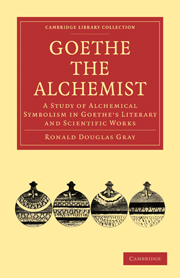X - Male and Female
Published online by Cambridge University Press: 10 November 2010
Summary
The last two chapters have traced the pattern of development implicit in the Urpflanze and in Goethe's Colour-Theory through some of its stages. The ideas of renunciation, discovery of a central point, and steady development towards perfection, jointly portrayed by these two theories, have begun to emerge also from Goethe's description of his life, and from his purely literary work. It remains now to show how the final stage, the union of the polar opposites, represented in the plant by the union of the two sexes, and in the Colour-Theory by the colour red, was also frequently in Goethe's mind in his non-scientific writings. The fact that, in the Urpflanze, the truly final stage is represented by the seed, need arouse no objection. Just as the Philosophers' Stone was sometimes called a tincture or quintessence, and sometimes a hermaphrodite, according to the quality it was desired to emphasize, so also the two stages in the Urpflanze are equally representative of perfection. The present chapter, therefore, will deal solely with Goethe's use of the symbol of the hermaphrodite, and its influence of his thought as a whole.
The alchemists were not alone in describing perfection as a combination of the two sexes. The idea was known to Plato, and to the Gnostics and Cabbalists, both of whom, however, were more closely connected with the alchemical tradition.
- Type
- Chapter
- Information
- Goethe the AlchemistA Study of Alchemical Symbolism in Goethe’s Literary and Scientific Works, pp. 221 - 249Publisher: Cambridge University PressPrint publication year: 2010First published in: 1952



